There are 12 Jyotirlinga in India, The term Jyotirlinga refers to a sacred pilgrimage site in Hinduism associated with Lord Shiva, one of the principal deities in the Hindu divinity. The Jyotirlinga is a devotional representation of the Hindu god Shiva. There are a total of twelve Jyotirlinga in India, each of which is believed to be a manifestation of Lord Shiva’s divine light or lingam.
At all these sites, the primary image is a lingam, representing the beginningless and endless stambha pillar, symbolizing the infinite nature of Shiva. These Jyotirlinga hold immense religious significance for millions of devotees and are revered as places of great spiritual energy and power.
The Origin of 12 Jyotirlinga
As per the Legends from the Shiva Purana, once, Brahma who is the god of creation, and Vishnu the god of preservation argued over their supremacy. To conclude this debate, Shiv pierced the three worlds, appearing as a huge, infinite pillar of light, the jyotirlinga. Brahma and Vishnu decided to ascend and descend across a pillar of light to find the end of the light in either direction. According to some iterations, Vishnu assumed his Varaha avatar to achieve this task, while Brahma rode a hamsa which is known as a swan.
Brahma lied that he had discovered the end of the light and produced a ketaki flower as proof, while Vishnu admitted that he could not find the end of the light from his journey. The dishonesty of Brahma becomes responsible for making Shiva angry, causing him to curse the creator deity that he would not be worshiped; he also declared that Vishnu would be eternally worshiped for his honesty. The jyotirlinga shrines are regarded to be the temples where Shiva appeared as a fiery column of light.
Dwadash jyotirlinga stotram
There is dwadash jyotirlinga stotram which describes the 12 Jyotirlingas, Shiva Dwadash Jyotirlinga Stotram is a powerful devotional hymn used to worship Lord Shiva. Jyotirlinga refers to the brightness sign of lord Shiva. There are a total of twelve holy jyotirlinga Temples in India. The Shiva Dwadasha Jyotirlinga Stotra is recited or chanted to worship those twelve jyotirlinga temples of lord Shiva.
Saurashtre Somanatham Cha Shrishaile Mallikarjunam
Ujjaiyinyam Mahakaalam Omkaram-Malleshwaram
Paralyam Vaidyanatham Cha Dakinyam Bheemashankaram
Setubandh To Ramesham Nagesham Darukavana
Varanasyam Tu Vishvesha Tryambakam Gautamitate
Himalaya Tu Kedaram Gushmesham Cha Shivalaye
Atani Jyotirlingani Sayam Pratah Pathennarah
Satta Janma Kritam Papam Smaranena Vinashyati
Dwadash jyotirlinga stotram
Dwadash jyotirlinga stotram lyrics in English
Somnath in Saurashtra and Mallikarjunam in Shri-Shailam; Mahakaal in Ujjain, Omkareshwar in Amleshwar.
Vaidyanath in Parali and Bhimashankar in Dakinya; Ramesham (Rameshwaram) in Sethubandh, Nagesham (Nageshwar) in Darauka-Vana.
Vishvanath in Varanasi, Tryambakam at the bank of the river Gautami, Kedarnath in the Himalayas, and Gushmeshwar in Shivalaya.
One who recites these Jyotirlingas every evening and morning, gets relieved of all sins committed in the past seven births. The one who visits these gets all his wishes fulfilled by Shiva’s grace and one’s karma gets eliminated as Maheshwara gets satisfied with the worship.
12 jyotirlinga images with name and place
There are 12 Jyotirlinga in India, which are situated in different states and cities. Below is the list of 12 Jyotirlinga along with city and state.
- Somnath – Gir Somnath, Gujarat
- Nageshwar – Daarukavanam, Hingoli, Gujarat
- Bhimashankar – Pune, Maharashtra
- Trimbakeshwar – Nashik, Maharashtra
- Grishneshwar – Aurangabad, Maharashtra
- Vaidyanath – Deoghar, Jharkhand
- Mahakaleshwar – Ujjain, Madhya Pradesh
- Omkareshwar – Khandwa, Madhya Pradesh
- Kashi Vishwanath – Varanasi, Uttar Pradesh
- Kedarnath – Kedarnath, Uttarakhand
- Rameshwaram – Rameswaram Island, Tamil Nadu
- Mallikarjuna – Srisailam, Andhra Pradesh
Read More about 51 Shakti Peetha
Somnath jyotirlinga
Somnath Jyotirlinga is traditionally considered the first pilgrimage site: the Dwadash Jyotirlinga pilgrimage begins with the Somnath Temple. The temple which was destroyed and rebuilt sixteen times, is held in reverence throughout India and is rich in legend, tradition, and history.
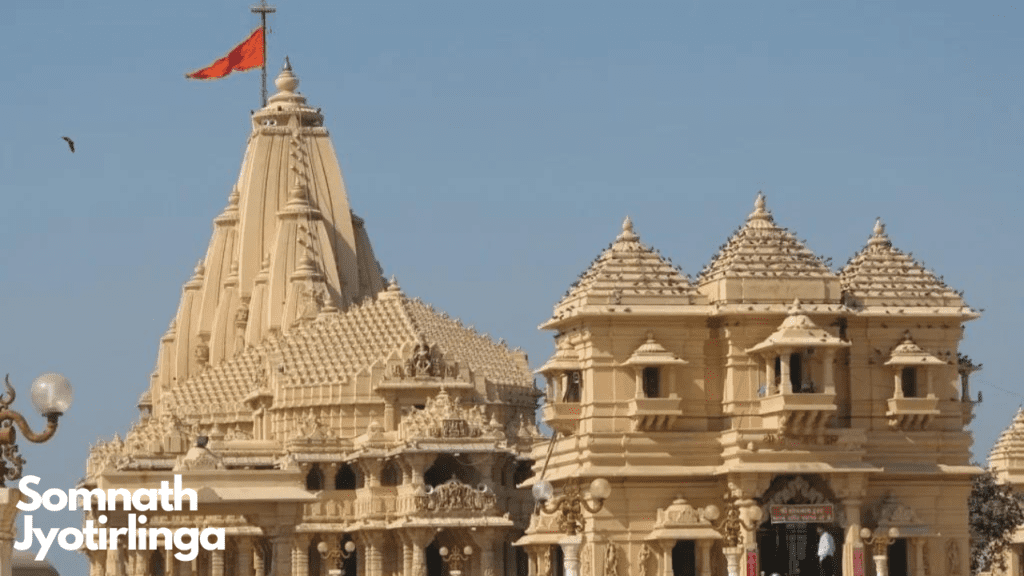
It is located at Prabhas Patan, Veraval in the Saurashtra region of Gujarat state in western India. This sacred shrine holds a special place in the hearts of millions of devotees as it symbolizes not only the divine presence of Lord Shiva but also the indomitable spirit of resilience exhibited by the temple.
The first recorded destruction in history took place in history when Mahmud of Ghazni, a Turkic invader, looted and vandalized the temple. Despite these repeated attacks, the devotees and rulers of the region continued to rebuild the temple each time it was desecrated.
The temple continues to inspire devotees and visitors alike, reminding them of the enduring power of devotion and the importance of preserving our rich cultural and religious heritage.
- Best time to Visit:- September to March
- Number of days required:- 3 to 4 days
Nageshwar jyotirlinga
Nageshwara Jyotirling is one of the twelve Jyotirlingas in India, which are temples dedicated to Shiva, located in Aundha Nagnath, Maharashtra. Some people believe that the Dwarka Shivalinga in Gujrat represents the Nageshwara Jyotirlinga. The distance from Dwarka to Nageshwar Jyotirlinga is 16.6 Km.
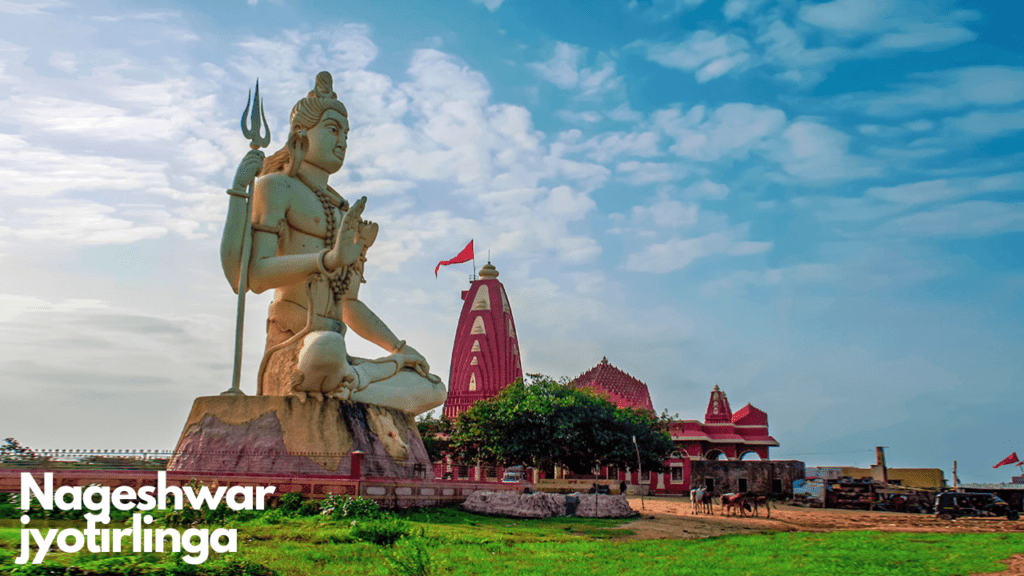
The Hindu mythology Shiva Purana says Nageshvara Jyotirlinga is in the Darukavana, which is an ancient name of a forest in India. The Darukavana is mentioned in Indian epics, like Kamyakavana, Dvaitavana, and Dandakavana.
A narrative mentioned in the Shiva Purana about the Nageshvara Jyotirlinga tells of a demon named Daruk, who attacked a Shiva devotee named Supriya and imprisoned him along with many others in his city of Darukavana, which is a city under the sea inhabited by sea snakes and demons. At the urgent urging of Supriya, the prisoners started to chant the holy mantra of Shiva.
Immediately after that, Shiva appeared and the demon was defeated, later residing there in the form of a Jyotirlinga. The demon had a wife, whose name was Daruka, who used to worshipped Mata Parvati. As a result of her punishment and devotion, Mata Parvati enabled her to master the forest, where she performed her devotions and renamed the forest ‘Darukavana’ in her honor. Wherever Daruka went the forest followed her.
To save the demons of Darukavana from the punishment of all the gods, Daruk summoned up the power Parvati had given her. She then moved the entire forest into the sea where they continued their campaign against the recluse, kidnapping people and keeping them confined in their new lair under the sea, which was how that great Shiva devotee, Supriya, had wound up there.
The arrival of Supriya caused a revolution. He then set up a lingam and made the prisoners recite the mantra Om Namaha Shivay in honor of lord Shiv while he prayed to the lingam. The demons’ response to the chanting was to try to kill Supriya, though they were frustrated when Shiva appeared and handed him a divine weapon that saved his life. Daruka and the demons were defeated, and goddess Parvati saved the remaining demons.
The lingam that Supriya had set up was called Nagesh, the tenth lingam. Shiva once again assumed the form of a Jyotirling with the name Nageshwar, while the Goddess Parvati was known as Maheshwari. God Shiva then announced that he would show the correct path to those who would worship him.
Read More about Nageshwar Jyotirlinga
- Best time to Visit:- October to March
- Number of days required:- single day
Bhimashankar jyotirlinga
Bhimashankar Jyotirlinga, situated in Maharashtra’s Sahyadri Range, is a revered pilgrimage site dedicated to Lord Shiva. Rooted in Hindu mythology, it is believed that Pandava prince Bhima sought penance here. The temple, with its Nagara-style architecture, is surrounded by lush greenery and is a harmonious blend of spirituality and natural beauty.
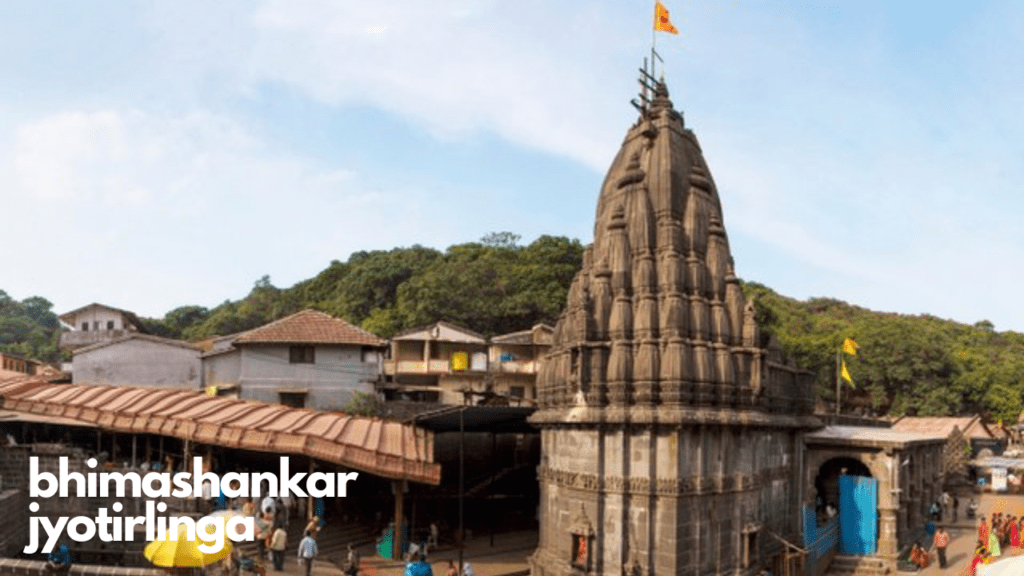
Devotees believe that a visit to Bhimashankar can cleanse sins and bestow divine blessings. The annual Maha Shivaratri celebration attracts pilgrims, making this Jyotirlinga a symbol of faith and tranquility amidst the scenic splendor of the Western Ghats.
The history of Bhimashankar Jyotirlinga is deeply rooted in Hindu mythology. According to a legend, Bhima, one of the Pandava brothers from the Mahabharata epic, sought forgiveness for his sins after the Kurukshetra War. He was advised to visit Kashi (Varanasi) to perform penance and seek Lord Shiva’s blessings.
However, Bhima’s immense strength and impatience led him to carry a massive lingam (the symbol of Lord Shiva) from the banks of the river Bhima to the Sahyadri Mountains. He rested and placed the lingam on the ground in the current location of Bhimashankar.
This is said to be the divine origin of the Jyotirlinga. Historical records suggest that Bhimashankar was a revered place of worship for centuries. The temple and the surrounding region have witnessed the patronage of various dynasties, including the Marathas and the Peshwas. These rulers contributed to the temple’s maintenance and development.
Bhimashankar Jyotirlinga holds immense religious significance for Hindus. It is believed that a visit to this sacred shrine and offering prayers to Lord Shiva here can wash away one’s sins and lead to spiritual enlightenment. The annual Maha Shivaratri festival is celebrated with great devotion, drawing the attention of pilgrims from different parts of India to participate in the nightlong rituals and seek the blessings of Lord Shiva.
- Best time to Visit:- October to February
- Number of days required:- 2 days
Trimbakeshwar jyotirlinga
The Trimbakeshwar Temple is near to Nashik in Maharashtra and is a jyotirlinga shrine associated with the origin of the Godavari River. It is located between three hills namely Brahmagiri, Nilagiri, and Kalagiri. The origins of Trimbakeshwar Jyotirlinga are deeply rooted in Hindu mythology. It is believed that Lord Brahma, Lord Vishnu, and Lord Shiva converged at this sacred spot and the divine light of Shiva manifested as the Jyotirlinga.
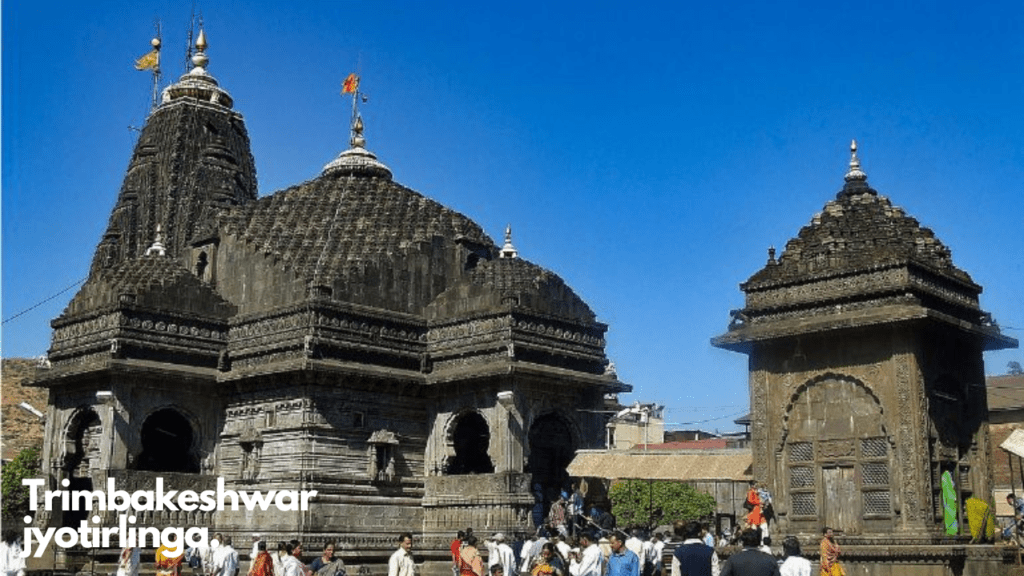
This temple has three lingas which is an iconic form of Shiva representing Shiva, Vishnu, and Brahma. The temple tank is called Amritavarshini, which is approximately 28 m by 30 m. There are three other water bodies, namely, Bilvatirtha, Viswanantirtha, and Mukundatirtha. There are images of numerous deities, namely, Ganga, Jaleswara, Rameswara, Gautameswara, Kedarnatha, Rama, Krishna, Parashurama and Lakshmi Narayana. The temple has also several religious houses and samadhis of saints.
According to the Legends, Shri Trimbakeshwar is a religious center having one of the twelve Jyotirlingas. The other feature of the Jyotirlinga located here is its three faces embodying Brahma, Vishnu, and Shiva. Due to the excessive use of water, the lingam has started to erode. It is said that this decrease symbolizes the eroding nature of human society.
These Lingas are covered by a jeweled crown which is placed over the Gold Mask of Trideva who are Brahma Vishnu and Mahesh. The crown is said to be preserved from the age of Pandavas and consists of diamonds, emeralds, and many precious stones. The crown is shown every Monday from 4-5 pm.
All other Jyotirling have Shiva as the main deity. The entire black stone temple is famous for its appealing architecture and sculpture and is at the foothills of a mountain called Brahmagiri. Godavari’s three sources originate from the Brahmagiri mountain.
Read more about Trimkashwar Jyotirlinga
- Best time to Visit:- November to February
- Number of days required:- Single day
Grishneshwar jyotirlinga
Grishneshwar Jyotirlinga Temple or Grushneshwar is a Jyotirling mandir of Shiva in Verul village of Aurangabad district, located in Maharashtra. It is one of the 12 Jyotirlingas in India. The Temple is a nationally protected site, one and a half kilometers away from UNESCO World Heritage Site.
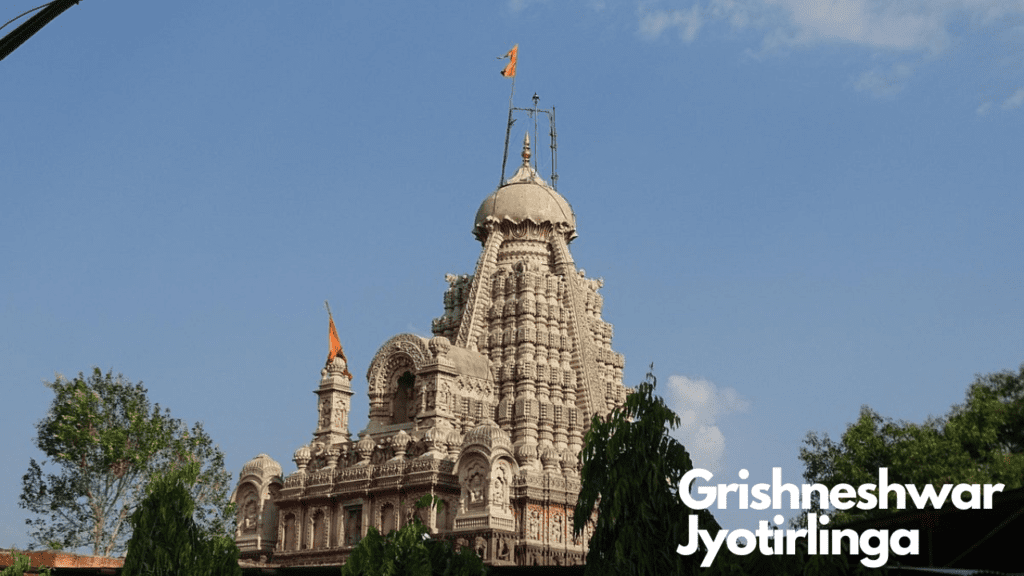
The temple structure was destroyed by the Delhi Sultanate in the 13th and 14th centuries. The Grushneshwar temple went through several rounds of rebuilding followed by re-destruction during the Mughal-Maratha conflict. The temple was rebuilt in its current form in the 18th century under the sponsorship of Queen Ahilyabai Holkar of Indore, after the fall of the Mughal Empire.
It is presently an important and active pilgrimage site of the Hindus and attracts long lines of devotees daily. Anyone can enter the temple premises and its inner chambers, but to enter the garbha-griha of the temple, the local Hindu tradition demands that men must go bare-chested.
The temple was re-constructed by Maloji Bhosale of Verul, who was the grandfather of Chhatrapati Shivaji Maharaj in the 16th century and later again by Queen Ahilyabai Holkar in the 18th century. She is assigned to rebuild some of the major Hindu temples such as the Kashi Vishvanath temple in Varanasi, a Vishnu temple in Gaya, and a much larger Shiva Jyotirlinga temple in Somnath Temple.
- Best time to Visit:- September to March
- Number of days required:- Single day
Vaidyanath jyotirlinga
The Vaidyanatha temple, also known as Baba Baidyanath Dham is a Hindu temple dedicated to god Shiva. The temple is located in Deoghar, in the Santhal Parganas division of the Indian state of Jharkhand. The temple complex consists of the central shrine of Baba Baidyanath along with additional 21 other temples.
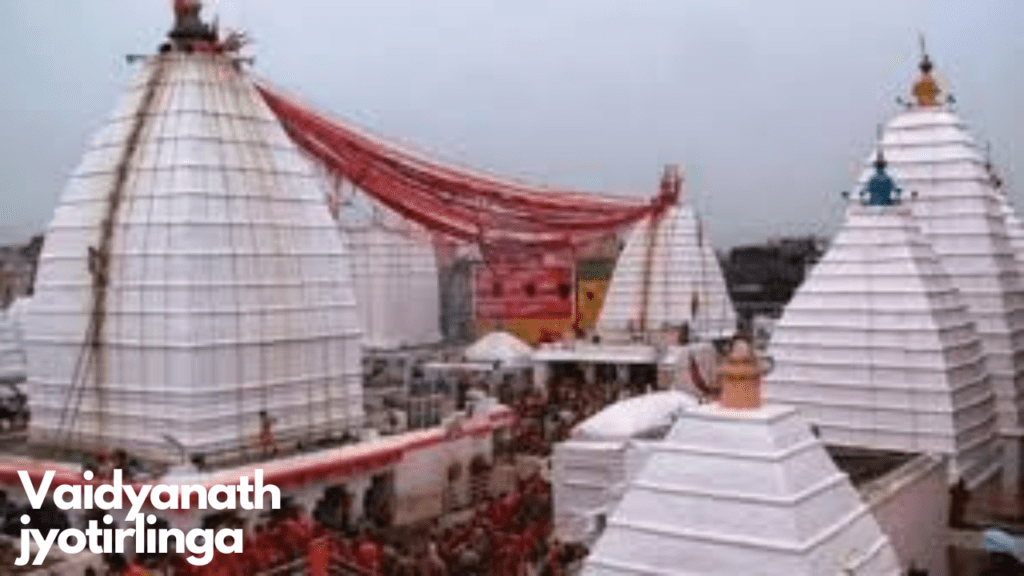
As per the legends, Ravan was performing punishment in the Himalayan region to appease Shiva. Ravan offered nine of his heads as an offering to Shiva. As he was to sacrifice his tenth head, Shiva appeared before him and Showed satisfaction with the offering, Then, Shiva asked what boon he desired. He asked to take the Kamna Linga to the island of Lanka and expressed his desire to take Shiva from Kailash to Lanka.
Lord Shiva agreed to Ravana’s request but with the condition that if the lingam was placed en route, it would become the permanent abode of the deity and could never be moved.
Other gods became worried upon hearing that Shiva had departed from his abode on Mount Kailash. They sought a resolution from Vishnu. The god Vishnu asked Varun Deva, the deity associated with water, to enter Ravan’s stomach through achamana, a ritual that involves sipping water from the palm of one’s hand. As a consequence of performing shaman, Ravana departed for Lanka with the lingam and felt the need to urinate in the backyard of Deoghar.
The story goes that Vishnu took the form of a cattleman whose name was Baiju. While Ravana was off to urinate, he gave a lingam to Baiju and positioned the lingam on the ground. Upon Ravana’s return, he attempted to displace the lingam, but he was unsuccessful in his endeavor. He became very upset and proceeded to press his thumb onto the lingam before departing. The Shiva lingam was then worshipped by Brahma, Vishnu, and other deities. Since then, Mahadev has taken up residence in Deoghar as the embodiment of the Kamna Linga.
- Best time to Visit:- October to March
- Number of days required:- 2 days
Mahakaleshwar jyotirlinga
Mahakal situated in Ujjain in the state of Madhya Pradesh is home to the Mahakaleshwar Jyotirlinga temple. The shivlingam at Mahakal is believed to be Swayambhu, the only one of the 12 jyotirlingams to be so. This jyotirlinga is also the only one facing south and also the temple to have a Shree Rudra Yantra perched upside down at the ceiling of the Garbhagriha where the Shiv Lingam placed, is a place where Shakti Peetha and jyotirlinga are together.
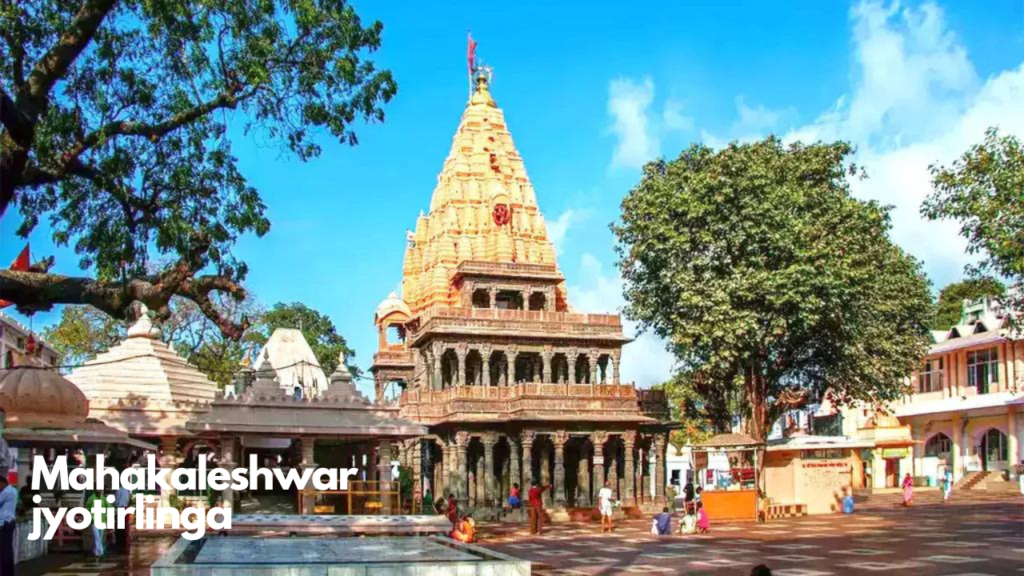
As per Hindu mythology Shiva Purana, Brahma, and Vishnu once argued over who was supreme in the creation. To take a test of them, Shiva pierced the three worlds as an endless pillar of light, the jyotirlinga. Vishnu and Brahma decide to travel along the pillar downwards and upwards respectively, to find the end of the light. Brahma lied that he had found the end, while Vishnu admitted his defeat.
Shiv then appeared as a second pillar of light and cursed Brahma that he would have no place in ceremonies while Vishnu would be worshipped till the end of eternity. The jyotirlinga is the supreme true reality, out of which Shiva partly appears. The jyotirlinga shrines are places where Shiva appeared as a fiery column of light. There are a total of 64 forms of Shiva, not to be confused with Jyotirlinga.
- Best time to Visit:- October to March
- Number of days required:- 1 day
Omkareshwar jyotirlinga
Omkareshwar is in Madhya Pradesh on an island in the Narmada River and is home to a jyotirlinga shrine and the Mamaleshwar temple. There are two main temples of Shiva here, one to Omkareshwar whose name means Lord of Omkara or the Lord of the Om sound located on the island, and one to Mamleshwar whose name means Immortal Lord or Devas located on the southern bank of the Narmada River.
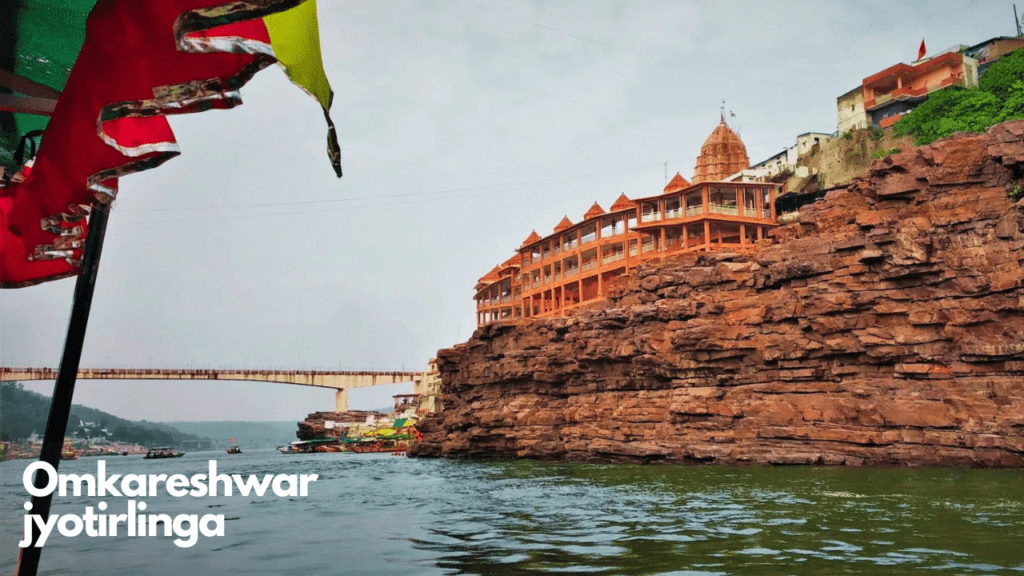
Madhya Pradesh has two Jyotirlingas, the second one, is Mahakaleshwar Jyotirlinga which is situated about 140 km north of Omkareshwar Jyotirlinga. The origin of Omkareshwar Jyotirlinga is deeply entwined with Hindu mythology. It is said that once upon a time, the Devas (celestial beings) and Asuras (demons) churned the ocean to obtain the nectar of immortality.
During this cosmic event, a pot of poison emerged, threatening to destroy the universe. Lord Shiva, in his benevolence, consumed the poison to save creation. Overwhelmed by the intensity of the poison, Shiva danced the Tandava, and drops of sweat fell into the Narmada River, giving rise to the sacred island of Mandhata and the Jyotirlinga of Omkareshwar.
According to Hindu legend Vindhya, the deity controlling the Vindhyachal mountain range was worshipping Shiv to appease himself for the sins committed. He created a sacred geometrical diagram and a Lingam which was made of sand and clay. Shiva became pleased with the worship and is believed to have appeared in two forms, namely Omkareshwar and Amaleswara. Since the mud mound appeared in the form of Om, the island came to be called Omkareswar. There is a place for Parvati and Ganapati in the temple.
Philosophy of Omkaar says that Advait Matt says Omkaar is composed of two words, Om which is sound, and Akaar which means srishti. Both are one not two since Advait means “not two”. Om beej mantra of Srishti, itself is the creator of Srishti.
- Best time to Visit:- October to March
- Number of days required:- 1 Day
Kashi Vishwanath Jyotirlinga
The Kashi Vishwanath Temple is located in Varanasi, Uttar Pradesh is home to the Vishwanath Jyotirlinga shrine, which is perhaps the most sacred of Hindu shrines. The origins of Kashi Vishwanath Jyotirlinga are intricately woven into Hindu mythology.
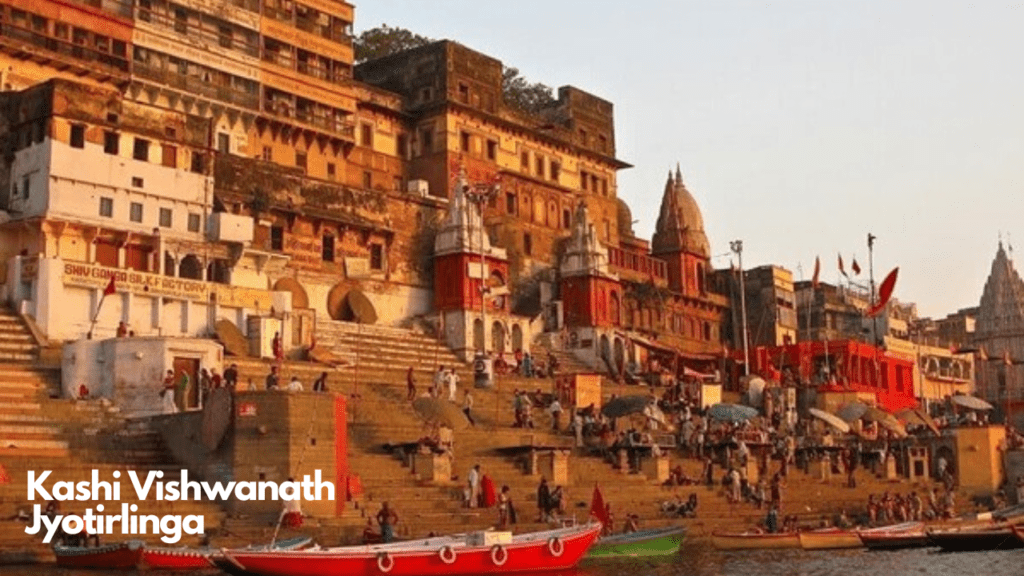
Legend has it that Lord Shiva himself established this divine lingam, making it one of the most significant among the twelve Jyotirlingas. The city of Varanasi, known as Kashi, is believed to be the eternal abode of Lord Shiva, where salvation can be attained.
Madhuri Desai pens those accounts of the history of the temple center around a refraining from repeated destruction and reconstruction. Devotees visiting the present Kashi Vishwanath Temple are informed about the timelessness of the lingam.
Kashi Vishwanath Jyotirlinga witnesses grand celebrations during festivals such as Maha Shivaratri. Pilgrims, scholars, and spiritual seekers gather to participate in rituals, discourses, and cultural events, creating an atmosphere charged with devotion and divine energy.
- Best time to Visit:- All the months majorly November to February
- Number of days required:- Single day
Kedarnath Jyotirlinga
Kedarnath is located in Uttarakhand and is revered as the northernmost and the closest jyotirling to Lord Shiva’s eternal abode of Mount Kailash. Kedarnath forms a part of the smaller Char Dham pilgrimage circuit of the Hindu religion. Kedarnath, situated in the snow-clad Himalayas, is an ancient shrine, rich in legend and tradition.
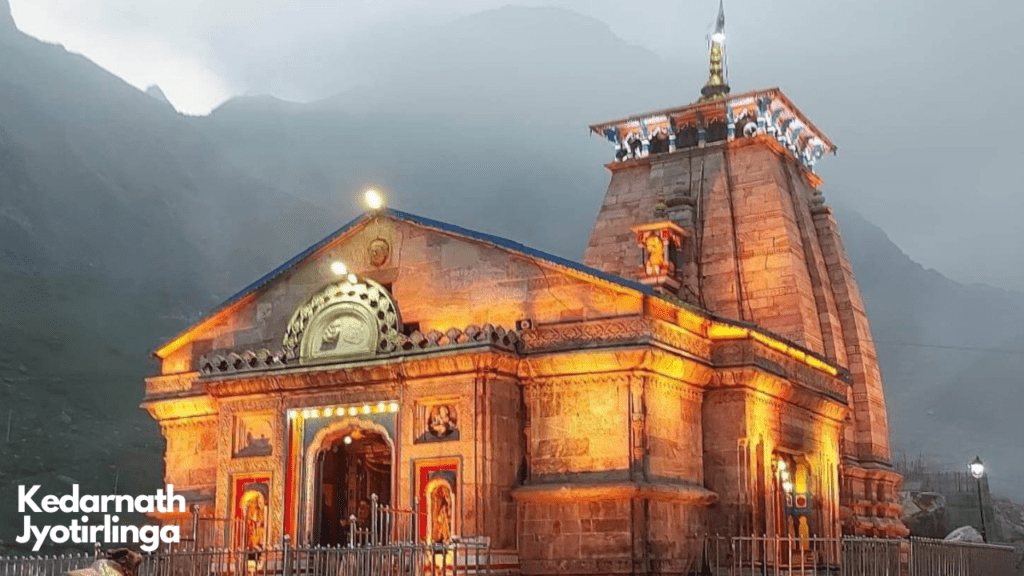
It is reachable only for six months a year. Shiv assumed the form of wild boar and divided into the earth at Kedarnath to emerge at Doleshwor in Kathmandu Valley, Nepal, Pure ghee was applied at Kedarnath lingam as the boar was injured.
The origins of Kedarnath Jyotirlinga are rooted in Hindu mythology. It is believed that after the Kurukshetra War in the Mahabharata, the Pandavas sought Lord Shiva’s blessings to atone for the sins of fratricide and destruction.
Lord Shiva avoided them and took refuge in Kedarnath in the form of a bull. When discovered, Shiva dived into the ground, leaving behind a hump. The hump is worshipped as the Jyotirlinga, and the conical rock formation at Kedarnath is considered the remains of his divine presence.
Historical records indicate that Kedarnath was a well-established pilgrimage site during the reign of the Guptas and the Mauryas in ancient India. Pilgrims would undertake arduous journeys to seek blessings at the temple, just as they do today.
Kedarnath Jyotirlinga is considered to be one of the holiest shrines for Hindus. A visit to the temple is believed to wash away one’s sins and grant moksha, or liberation from the cycle of birth and death. The temple is open to pilgrims only for six months each year, from April to November, due to the extreme weather conditions in the region.
- Best time to Visit:- April to June
- Number of days required:- 2 to 3 days
Rameshwaram Jyotirlinga
Ramanathaswa Temple is a Hindu temple which is dedicated to the Hindu god Shiva located on Rameswaram island in the state of Tamil Nadu, India. The temple is also on the list of one of the twelve Jyotirlinga temples. It is one of the 275 Paadal Petra Sthalams, where Nayanars who are Saivite saints, Appar, Sundarar, and Tirugnana Sambandar, have glorified the temple with their songs.
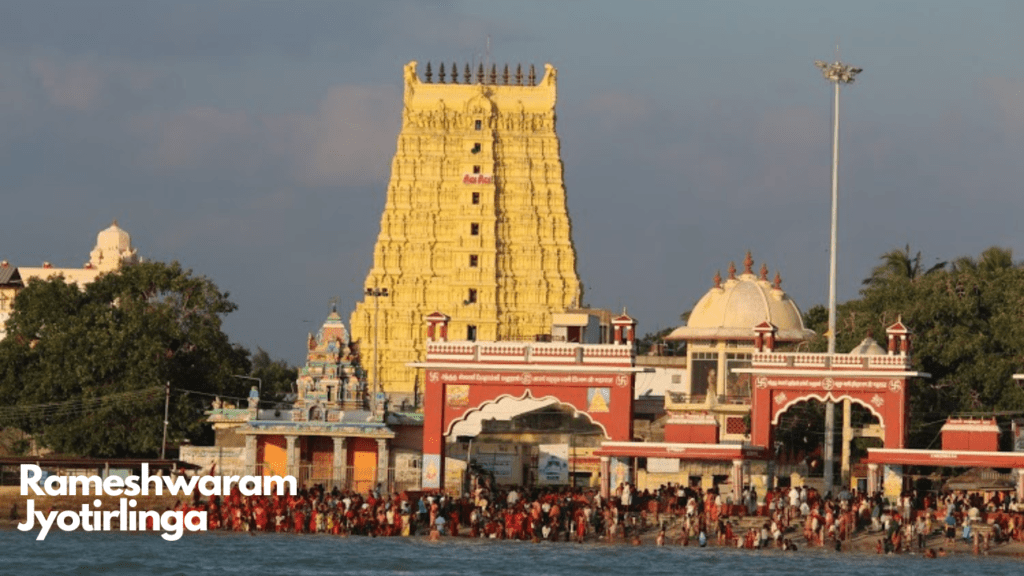
It was expanded during the 12th century by the Pandya Dynasty, and its principal shrine’s holy place was renovated by Jeyaveera Cinkaiariyan and his successor Gunaveera Cinkaiariyan, monarchs of the Jaffna kingdom. Rameshwaram temple has the longest corridor among all Hindu temples in India, which was built by King Muthuramalinga Sethupathy.
The Mythological epic accounts depict the presiding deity, the Lingam of Ramanathaswamy Shiva, as having been established and worshiped by Rama before he crossed his bridge to the present-day island of Sri Lanka. It is under the list of one of the Char Dham pilgrimage sites.
According to the Hindu epic Ramayana, Ram, the seventh avatar of the god Vishnu, prayed to Shiva here to absolve any sins that he might have committed during his war against the demon king Ravan in Sri Lanka.
According to the Puranas in Hindu scriptures, upon the advice of sages, Rama along with his wife Sita and his brother Lakshmana, installed and worshipped the lingam(an iconic symbol of lord Shiva here to expiate the sin of Brahmahatya incurred while killing Ravana who was a Brahmin and son of Vishrava.
To worship lord Shiva, Ram directed his trusted lieutenant Hanuman avatar of Shiva himself to bring it from the Himalayas. Since it took longer to bring the lingam, Devi Sita built a lingam made of sand from the nearby seashore, which is also believed to be the one in the sanctum of the temple.
This account is well supported by the original Ramayana authored by Valmiki where it is written in Yudha Kanda. According to another version, as quoted in Adhyatma Ramayana, lord Ram installed the lingam before the construction of the bridge to Lanka.
- Best time to Visit:- October to April
- Number of days required:- 2 days
Mallikarjuna Jyotirlinga
Mallikārjuna Jyotirling also called Śrīśaila, is located on a mountain in Kurnool District in Rayalaseema. The Mallikarjuna is an ancient temple that is architecturally and sculpturally rich and A place where Shakti Peeth and jyotirling are together. Adi Shankara which is the combination of Adi Shakti and Shiva composed his Shivananda Lahari here.
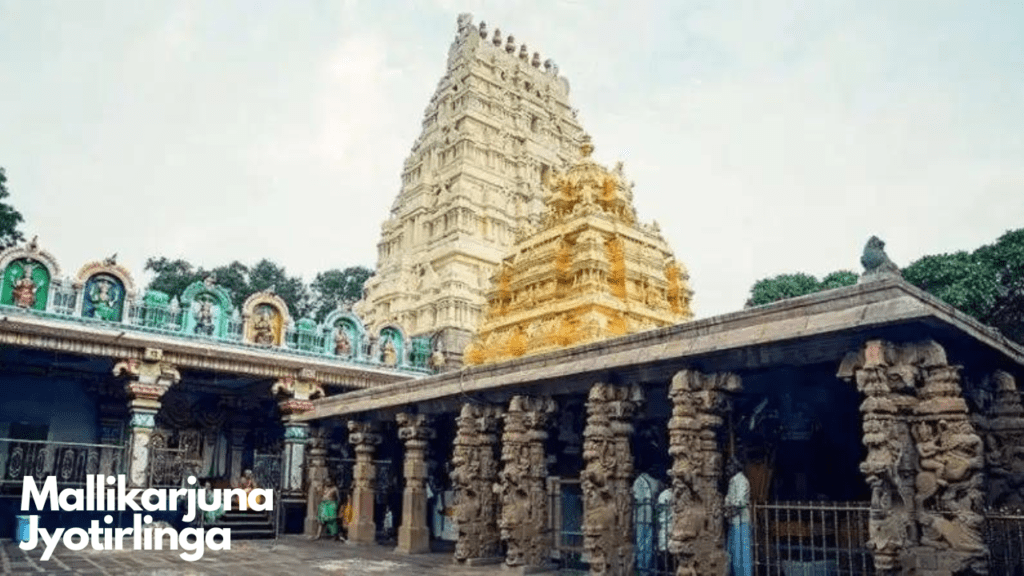
According to the legends When Shiv and Parvati decided to find suitable brides for their sons. Shiv got Buddhi which means intellect, Siddhi which means spiritual power, and Riddhi which means prosperity married to Ganesha.
Kartikeya on his return was angered and went away to stay alone on Mount Krauncha in Palani in the name of Kumara Brahmachari. On seeing his father coming over to appease him he tried to move to another place, but on the request of the Devas, stayed close by. The place where Shiv and Parvati stayed is called Srisailam.
As per Hindu legend, the presiding deity in the form of Linga (an iconic form of Shiva) was worshipped with jasmine, leading to the name of the presiding deity as Mallikarjuna.
- Best time to Visit:- October to February
- Number of days required:- 2 to 3 days
Frequently Asked Questions
Distance from Hydrabad to Mallikarjuna Jyotirlinga?
The distance between Hydrabad to Mallikarjuna Jyotirlinga is 22.3 Km which takes around 1 hour by road.
Distance from Ujjain to Omkareshwar Jyotirlinga?
The Distance From Ujjain to Omkareshwar Jyotirlinga is 138.2 Km which takes approximately 4 hours by road.
Which jyotirlinga to visit last?
The last of the 12 jyotirlingas in India, the Mallikarjuna Jyotirlinga temple is perched on the hilltop of the Shri Saila Mountain. You can view the Krishna river from the temple which is decorated with excellent architecture and sculptures.
What is the difference between shivaling and jyotirlinga?
Jyotirlinga and Shivalinga, both are devotional objects, which are worshiped by Lord Shiva. But, the basic difference is that the Shivalinga can be established by humans in the temple or any place, but Jyotirlinga cannot. Jyotirlinga is believed to have emerged from Earth itself.
Which Jyotirlinga can be touched?
Bhimashankara, the sixth sacred abode of Lord Shiva is situated on the hills of Sahyadri Range in Maharashtra. Tourists from across the world can enter the Sanctorum in the Maratha-style temple made up of black stone and touch the Jyotirlinga.
Which jyotirlinga is less crowded?
Grishneshwar Temple is an ancient pilgrimage site revered as the abode of one of the 12 Jyotirlinga manifestations of Lord Shiva. The temple is quite restful and calm with a very small crowd.
Why is it called Jyotirlinga?
The word Jyoti means light which is also called ‘radiance’ and lingam or linga means ‘sign’ or ‘image’. So the word Jyotirlinga means ‘Radiant signs of Lord Shiva’.
Do ladies touch Shivling?
According to Hindu mythology women should not touch the Shivling, and everyone should stay away from non-veg food, onion, garlic raw milk, etc, throughout Shravan Mass.
Which organ is Shivling?
The popular belief is that the Siva Lingam represents the phallus or the virile organ, the emblem of the generative power or principle in nature.
How To reach Mallikarjuna Jyotirlinga temple?
You can reach the temple by air, the nearest airport is Rajiv Gandhi international Airport in Hyderabad approximately 220 Km away, by road you can take buses that ply regularly from the major cities in Andhra Pradesh, by train the nearest railway to Mallikarjuna Jyotirlinga is Markapur railway station which is 85 Km from Temple.
Why is Jyotirlinga special?
Jyotirlinga is the sacred place of Lord Shiva. Lord Shiva himself is believed to have visited these places and thus holds a special place in the hearts of devotees and pilgrims. There are 12 in India. Jyotirlinga means Sun Pillar.
Which is the largest crowded temple in India?
The Srirangam Ranganathaswamy Temple is dedicated to Maha Vishnu The Supreme deity of Vaishnavism. The temple is listed as the largest functioning Hindu temple around the globe.
What is the logic behind jyotirlinga?
The twelve jyotirlinga sites take the names of their respective presiding deity, and each is considered a different manifestation of Shiva. At all these Places, the primary image is a lingam, representing the beginningless and endless stambha pillar, symbolizing the boundless nature of Shiva.
Who took Shivling from Ravana?
Aided by Shiva’s son Ganesha, the gods devised a plan and tricked Ravana into handing the linga to Ganesha, who immediately placed it on the ground. The Temples at Gokarna was the spot where the atma linga was placed.
Which color Shivling is good for home?
Black color ceramic made SHIVLING best to put at home temple Compact small size.
Why is Shivling kept in water?
It is believed that water is an electrolyte, which transmits energy much faster than air. Thus, pouring holy water on Shiva Linga releases powerful vibrations and electrifies the deity. This helps in cleansing the negativity in the aura and corresponds to the mind and water as one.
Which is the nearest railway station to Mallikarjuna Jyotirlinga?
The Nearest railway to Mallikarjuna Jyotirlinga is Markapur railway station which is 85 Km from Temple.
Why milk is poured on Shivling?
Milk is offered to Shiva Linga to keep the Shiva lingam cool and to protect it from atmospheric conditions. Milk forms a protective layer on Shiva lingam and prevents it from erosion.
What is the purest form of Shivling?
The purest and most sought-after form is the quartz crystal (Sphatika), a natural stone not carved by man but made by nature, gathered molecule by molecule over hundreds, thousands, or millions of years, grown as a living body grows, but boundless more slowly.

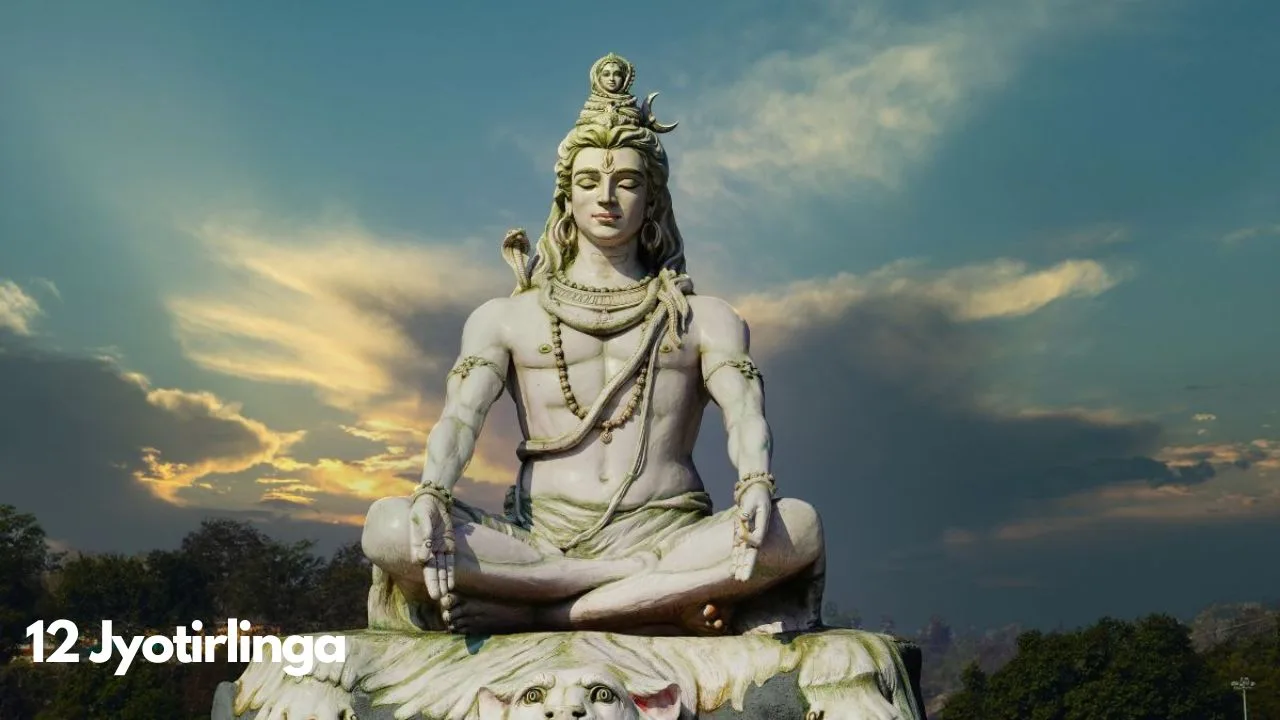
Scattered across the vast expanse of India, the 12 Jyotirlingas stand as revered shrines dedicated to Lord Shiva, the supreme deity of creation, preservation, and destruction. These radiant pillars of light, each embodying a unique aspect of Shiva’s divine essence, draw pilgrims from far and wide, seeking spiritual solace and enlightenment.
The Somnath Jyotirlinga, nestled along the Gujarati coast, exudes an aura of ancient wisdom, while the Nageshwar Jyotirlinga, nestled amidst the lush greenery of Uttarakhand, radiates an otherworldly serenity. The Bhimashankar Jyotirlinga, perched atop the Sahyadri Hills, resonates with the power of the elements, while the Trimbakeshwar Jyotirlinga, concealed within the sacred Trimbakeshwar Caves, exudes an aura of mystery and devotion.
The Grishneshwar Jyotirlinga, situated in the heart of Ellora’s architectural marvels, blends seamlessly into the grandeur of its surroundings. The Vaidyanath Jyotirlinga, nestled amidst the verdant beauty of Jharkhand, emanates a healing energy. The Mahakaleshwar Jyotirlinga, pulsating with the vibrant spirit of Ujjain, embodies Shiva’s transformative power.
The Omkareshwar Jyotirlinga, gracing the banks of the Narmada River, reverberates with the sacred sound of ‘Om’, the primordial vibration. The Kashi Vishwanath Jyotirlinga, nestled amidst the labyrinthine lanes of Varanasi, pulsates with the spiritual energy of the ancient city. The Kedarnath Jyotirlinga, nestled amidst the snow-capped peaks of the Himalayas, embodies Shiva’s untamed majesty.
The Rameshwaram Jyotirlinga, gracing the shores of southern India, exudes an aura of peace and tranquility. The Mallikarjuna Jyotirlinga, nestled amidst the rolling hills of Srisailam, embodies Shiva’s harmonious union with Parvati.
Together, the 12 Jyotirlingas form a sacred pilgrimage circuit, beckoning devotees to embark on a spiritual journey of self-discovery and divine communion.